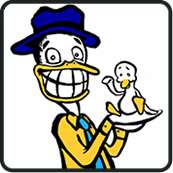1. You must clean the bottles thoroughly, so be sure to use your bottling brush and get all the crud out of your bottles. Afterwards, sanitize the following items: bottling bucket, bottles, bottle caps, plastic hose, saucepan, mixing spoon
2. Make sure you have enough bottles to contain your new brew. Five gallons of beer is equivalent to approximately 640 ounces, so you need to plan accordingly (e.g., if you have 16-ounce bottles you'll need about 40).
3. Make your priming solution: take a saucepan, put two or three cups of water in it, and dissolve 3/4 cup of dextrose in the water. Bring the solution to a boil over medium heat, and then cover it and set it aside to cool for one hour.
4. After the priming solution has cooled, place the bottling bucket on the floor. Place the primary fermenter on a chair, table or counter directly above the bottling bucket. Attach the plastic hose to the spigot on the primary fermenter and put the other end of the hose in the bottom of the bottling bucket.
5. Pour the priming solution into the bottling bucket, and then open the spigot on the fermenter, allowing the beer to flow into the bucket and mix with the solution. Don't try to get the last of the beer out of the fermenter, because it contains crap you don't want.
6. Then get the fermenter out of the way and put the bottling bucket up where it was and hook up the hose to its spigot. Line up all your bottles on the floor underneath it and stick the hose into one of the bottles. Then you're ready to open up the spigot on the bottling bucket and let the beer fly. Stick the hose in all the way to the bottom, and when the beer gets really near the top, yank the hose out and stick it in the next bottle. The level in the bottle drops when you take the tube out, and you want to leave about one inch of airspace at the top of the bottle.
7. Once all the beer has drained out of the bucket, get it out of the way and get ready to put the caps on your bottles. You need to do this right away, because every second that your beer remains exposed to the elements is a bad second.
8. Once you've got all your bottles capped, you need to find a cool, dark place to put them while secondary fermentation takes place. They should not go in your fridge.
9. You have to leave your beer there for a minimum of two weeks before you can drink any of it.
SoYouWanna know more? Check out our full-length article SYW Make Your Own Beer?

